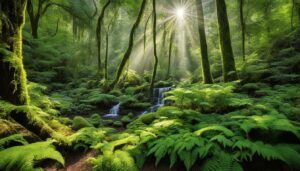Did you know that ponds are home to an astonishing variety of native wildlife? These seemingly small bodies of water hold a stunning world beneath their tranquil surfaces. From the tiny creatures that dart among the aquatic plants to the graceful waterfowl that skim across their glassy edges, ponds are bustling ecosystems teeming with life.
In this article, we will delve into the fascinating world of ponds and discover the importance of these habitats for indigenous wildlife. We will explore the intricate web of relationships that exist within pond ecosystems and highlight the strategies for conserving and revitalizing these vital habitats for the benefit of both wildlife and our planet.
Key Takeaways:
- Ponds are home to a diverse range of native wildlife, both big and small.
- These aquatic habitats play a crucial role in maintaining biodiversity.
- Conserving and revitalizing pond ecosystems is essential for the survival of indigenous wildlife.
- By creating healthy pond habitats, we can support a thriving community of plants, animals, and insects.
- Residential garden ponds offer multiple benefits for wildlife and contribute to urban biodiversity.
Revitalizing Biodiversity Through Pond Restoration
Restoring and creating ponds is a key strategy for revitalizing biodiversity. The loss of ponds due to drainage and pollution has resulted in a decline in freshwater biodiversity. The guide developed by the UCL Pond Restoration Research Group offers valuable insights into restoring “ghost ponds” and managing existing ponds, as well as creating new ponds to support thriving ecosystems. By following these restoration techniques, we can protect against future species decline and contribute to the conservation of indigenous wildlife.
“Pond restoration is not just about bringing back the water, it’s about reviving entire ecosystems.” – UCL Pond Restoration Research Group
Pond restoration involves a comprehensive approach to bring back the natural balance and abundance of species. The process includes removing excess sediment, re-establishing suitable vegetation, and controlling invasive species. By restoring the ecological conditions that support diverse habitats, we can promote the recovery of freshwater biodiversity.
Reviving “ghost ponds” is a critical aspect of pond restoration. These are abandoned ponds that have become filled with debris or vegetation over time. Restoring ghost ponds involves clearing and reintroducing water to these neglected habitats, creating new opportunities for wildlife to thrive.
Creating new ponds is also an effective strategy for promoting biodiversity conservation. By strategically selecting locations and considering factors such as water availability and vegetation cover, we can establish ponds that provide essential habitats for a wide range of species. These newly created ponds contribute to the overall ecological health of the surrounding area and enhance local biodiversity.
Furthermore, pond restoration plays a crucial role in environmental protection. Healthy ponds act as natural filters, purifying water and improving overall water quality. They also help prevent soil erosion, regulate water levels, and contribute to climate regulation. By restoring and creating ponds, we contribute to the preservation of freshwater ecosystems and the long-term sustainability of our planet.
Ponds Native Wildlife
Creating and managing healthy pond habitats is essential for supporting native wildlife. Healthy ponds have clean water, diverse native plant life, and natural vegetation surrounding them. This section will discuss the importance of maintaining pond health, including techniques such as water quality management, vegetation control, and wildlife monitoring. By implementing these strategies, we can create thriving habitats that support a wide range of species.
Creating and Managing Healthy Pond Habitats
Pond management techniques are crucial for maintaining the health and vitality of pond ecosystems. Proper water quality management is essential to ensure the survival of aquatic species and maintain the overall balance of the pond. This involves monitoring and controlling nutrient levels, pH levels, and oxygen levels. Regular monitoring and testing can help identify any imbalances or issues that need to be addressed.
Vegetation control is another important aspect of maintaining healthy pond habitats. Native plants play a critical role in providing food, shelter, and breeding sites for wildlife. However, excessive plant growth can lead to overcrowding and the depletion of oxygen levels in the water. Implementing techniques such as mechanical harvesting, herbicide application, or biological control methods can help manage vegetation growth and maintain a balanced ecosystem.
Wildlife monitoring is a valuable tool for assessing the health of pond habitats. Observing and documenting the presence of different species can provide insights into the overall biodiversity and ecological balance of the pond. Tracking population trends and changes in species composition can help identify any potential threats or issues that require attention.
The Role of Ponds in Supporting Farmland and Natural Landscapes
Ponds in agricultural landscapes offer numerous benefits for both wildlife and the surrounding environment. They provide essential ecosystem services, such as water retention, nutrient cycling, and habitat creation. Ponds act as refuges for wildlife, providing food and shelter for a variety of species.
In farmland settings, ponds can play a crucial role in promoting pollination, which is essential for crop production. They attract pollinators such as bees and butterflies, increasing the efficiency of pollination and enhancing agricultural yields. Additionally, ponds can act as water sources for livestock and provide irrigation water for crops, contributing to the sustainability of agricultural practices.
Within natural landscapes, ponds are vital for maintaining biodiversity and providing habitat for a range of species. They support a variety of plants, insects, amphibians, birds, and mammals, creating a dynamic and interconnected ecosystem. The presence of healthy ponds within natural habitats contributes to the overall health and resilience of the landscape.
Importance of Clean Water and Natural Vegetation in Pond Ecosystems
Clean water is essential for supporting pond biodiversity and maintaining the overall health of pond ecosystems. It provides a suitable environment for aquatic species to thrive and reproduce. Regular water quality testing, pollution prevention measures, and the control of nutrient runoff are crucial for ensuring the cleanliness of pond water.
Natural vegetation, such as submerged plants and marginal vegetation, is vital for the stability and functionality of pond ecosystems. These plants offer food, shelter, and breeding sites for various wildlife. They contribute to water purification, oxygen production, and nutrient cycling. Maintaining natural vegetation in and around ponds is crucial for supporting the complex web of life that depends on these habitats.

Conclusion
Residential garden ponds offer a multitude of benefits for wildlife, making them a valuable addition to any backyard. These small-scale habitats provide essential resources such as food, water, and shelter for a diverse range of species including birds, insects, and amphibians. By creating wildlife-friendly gardens with ponds, homeowners not only contribute to urban biodiversity but also support local ecosystems and have the opportunity to enjoy the beauty of native wildlife in their own backyard.
The Benefits of Residential Garden Ponds for Wildlife
Garden ponds act as valuable wildlife habitats, attracting various species and serving as important stepping stones for their movement in urban areas. Backyard wildlife can benefit greatly from the presence of a pond, as it provides a reliable water source, breeding sites, and a diverse range of food options. Birds can drink and bathe, insects can find water for reproduction, and amphibians can use the ponds as breeding grounds. Moreover, garden ponds contribute to urban biodiversity, creating a harmonious coexistence between humans and wildlife.
Conservation Strategies for Protecting Indigenous Wildlife
Protecting indigenous wildlife in ponds requires dedicated conservation efforts. Habitat protection is crucial to ensure the survival of native species. By preserving and restoring natural habitats surrounding ponds, we can provide essential resources and safe spaces for wildlife. Additionally, species preservation aims to safeguard endangered and threatened species through targeted initiatives and monitoring programs. Implementing environmental stewardship practices, such as responsible gardening and reducing pollution, further enhances the conservation of indigenous wildlife in ponds.
Vernal Ponds: Seasonal Havens for Biodiversity
Vernal ponds, also known as seasonal wetlands, play a pivotal role in supporting biodiversity. These temporary ponds fill up during the spring and offer a unique environment for breeding and development. They serve as critical habitats for a wide range of species, including amphibians and invertebrates. To ensure the preservation of vernal ponds, it is essential to implement conservation measures that maintain water quality, protect the surrounding vegetation, and consider the ecological needs of the species that rely on these habitats. Ponds provide a thriving ecosystem for native wildlife, offering food, water, and shelter for a diverse range of species. They play an essential role in maintaining biodiversity and supporting the survival of indigenous wildlife. Restoring “ghost ponds,” managing existing ponds, and creating new ponds are key strategies for revitalizing biodiversity. Techniques developed by the UCL Pond Restoration Research Group offer valuable insights into pond restoration and conservation. Maintaining pond health involves techniques such as water quality management, vegetation control, and wildlife monitoring. By implementing these strategies, we can create thriving habitats that support a wide range of species. Ponds provide essential ecosystem services, such as water retention, nutrient cycling, and habitat creation. They act as refuges for wildlife, promote pollination, and provide water and food sources for birds and animals, enhancing the overall health of the landscape. Clean water promotes biodiversity by providing a suitable environment for aquatic species, while natural vegetation offers food, shelter, and breeding sites for various wildlife. Preserving these components is crucial for supporting the complex web of life that depends on pond ecosystems. Residential garden ponds act as small-scale habitats, providing food, water, and shelter for a variety of species, including birds, insects, and amphibians. Creating wildlife-friendly gardens with ponds can contribute to urban biodiversity and support local ecosystems. Conservation strategies include habitat protection, species preservation, and environmental stewardship. Implementing these strategies is crucial for ensuring the long-term survival of native species and the overall health of pond ecosystems. Vernal ponds, also known as seasonal wetlands, serve as vital breeding habitats for amphibians and invertebrates. These temporary ponds fill up during the spring, providing a unique environment for the reproduction and development of many woodland species. FAQ
How do ponds support native wildlife?
What can be done to revitalize pond ecosystems?
How can we ensure healthy pond habitats for native wildlife?
What is the role of ponds in supporting farmland and natural landscapes?
Why is clean water and natural vegetation important for pond ecosystems?
How can residential garden ponds benefit wildlife?
What are the conservation strategies for protecting indigenous wildlife in ponds?
Why are vernal ponds important for biodiversity?






